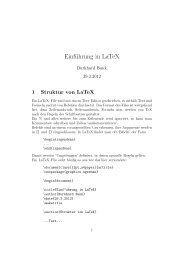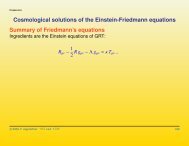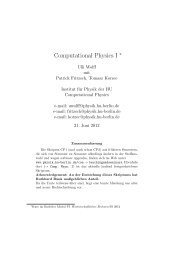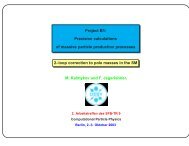Preprint[pdf] - HU Berlin
Preprint[pdf] - HU Berlin
Preprint[pdf] - HU Berlin
You also want an ePaper? Increase the reach of your titles
YUMPU automatically turns print PDFs into web optimized ePapers that Google loves.
The primary determination of the electron and muon masses come from measuring the ratio with respect<br />
to the mass of a nucleus and the masses are obtained in atomic mass units (amu). Therefore the ratios<br />
are known more precisely, than the numbers we get by inserting lepton masses given in MeV. In fact, the<br />
conversion factor to MeV is more uncertain than the mass of the electron and muon in amu.<br />
Note that the mass–dependent contributions in fact differ for ae, aµ and aτ, such that lepton universality<br />
is broken: ae �= aµ �= aτ.<br />
More SM parameters will be needed for the evaluation of weak and hadronic contributions. We have<br />
collected them in Appendix A together with known polylogarithmic functions needed for the representation<br />
of analytic results of the QED calculations.<br />
Until recently the electron anomaly ae and, until before the advent of the Brookhaven muon g−2 measurements,<br />
also aµ were considered to provide the most clean and precise tests of QED. In fact the by far largest<br />
contribution to the anomalous magnetic moment is of pure QED origin, and with the new determination of<br />
ae by the Harvard electron g−2 experiment [105,106] ae together with its QED prediction [108] allows for the<br />
most precise determination of the electromagnetic fine structure constant. The dominance of just one type of<br />
interaction in the electromagnetic vertex of the leptons, historically, was very important for the development<br />
of QFT and QED, as it allowed one to test QED as a model theory under simple unambiguous conditions.<br />
How important such experimental tests were we may learn from the fact that it took about 20 years from<br />
the invention of QED (Dirac 1928 [ge = 2]) until the first reliable results could be established (Schwinger<br />
1948 [a (2)<br />
e = α/2π]) after a covariant formulation and renormalization was understood and settled in its<br />
main aspects.<br />
When the precision of experiments improved, the QED part by itself became a big challenge for theorists,<br />
because higher order corrections are sizable, and as the order of perturbation theory increases, the complexity<br />
of the calculations grows dramatically. Thus experimental tests were able to check QED up to 7 digits in the<br />
prediction which requires one to evaluate the perturbation expansion up to 5 terms (5 loops). The anomalous<br />
magnetic moment as a dimensionless quantity exhibits contributions which are just numbers expanded in<br />
powers of α, what one would get in QED with just one species of lepton, and contributions depending<br />
on the mass ratios if different leptons come into play. Thus taking into account all three leptons we obtain<br />
functions of the ratios of the lepton masses me, mµ and mτ. Considering aµ, we can cast it into the following<br />
form [109,24]<br />
a QED<br />
µ = A1 + A2(mµ/me) + A2(mµ/mτ) + A3(mµ/me, mµ/mτ) . (45)<br />
Here A1 denotes the universal term common for all leptons. It also includes those diagrams with closed<br />
lepton loops that have the same mass as the external lepton. The term A2 depends on one scale and<br />
gets contributions from diagrams with closed fermion loops where the fermion differs from the external<br />
one. Such contributions start at the two loop level: for the muon as the external lepton we have two<br />
possibilities: an additional electron–loop (light–in–heavy) A2(mµ/me) or an additional τ–loop (heavy–in–<br />
light) A2(mµ/mτ) two contributions of quite different character. The first produces large logarithms ∝<br />
ln(mµ/me) 2 and accordingly large effects while the second, because of the decoupling of heavy particles in<br />
QED like theories 6 , produces only small effects of order ∝ (mµ/mτ) 2 . The two–scale contribution requires<br />
a light as well as a heavy extra loop and hence starts at the three loop order. We will discuss the different<br />
types of contribution in the following. Each of the terms is given in renormalized perturbation theory by an<br />
appropriate expansion in α:<br />
A1 = A (2)<br />
1<br />
�<br />
α<br />
�<br />
π<br />
+ A (4)<br />
1<br />
A2 = A (4)<br />
2<br />
�<br />
α<br />
�π α<br />
π<br />
� 2<br />
� 2<br />
+ A (6)<br />
1<br />
+ A (6)<br />
2<br />
A3 = A (6)<br />
3<br />
�<br />
α<br />
�π α<br />
�π α<br />
π<br />
� 3<br />
� 3<br />
� 3<br />
+ A (8)<br />
1<br />
+ A (8)<br />
2<br />
+ A (8)<br />
3<br />
�<br />
α<br />
�π α<br />
�π α<br />
π<br />
� 4<br />
� 4<br />
� 4<br />
+ A (10)<br />
1<br />
+ A (10)<br />
2<br />
+ A (10)<br />
3<br />
6 The Appelquist-Carrazone decoupling–theorem [110] implies that in theories like QED or QCD, where couplings and masses<br />
are independent parameters of the Lagrangian, a heavy particle of mass M decouples from physics at lower scales E0 as E0/M<br />
for M → ∞.<br />
20<br />
�<br />
α<br />
�π α<br />
�π α<br />
π<br />
� 5<br />
� 5<br />
� 5<br />
+ · · ·<br />
+ · · ·<br />
+ · · ·


![Preprint[pdf] - HU Berlin](https://img.yumpu.com/3833433/20/500x640/preprintpdf-hu-berlin.jpg)




